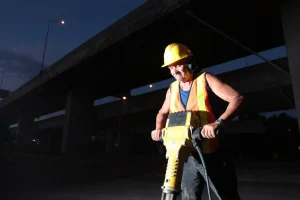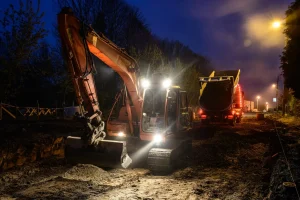Construction in the dark
Construction in the dark is a task that many construction workers in the UK are likely to have face at some point in their careers. This could be to undertake road works during the night or in winter when the daylight hours are shorter and those working past 5PM are forced into working in low light and darker conditions.
Working in the dark is therefore commonplace in the UK but that does not diminish the risks the workers face whilst working in poor visibility and employers and site managers should make sure that their workforce is equipped for working in dark conditions.
Worker risks:

One area that needs to be considered when workers are operating in the dark is that they are less likely to be alert to dangers. A lack of light will obviously lead to poorer vision, this requires greater concentration for the person to focus on the task, these risks are likely to be magnified in high-risk situations where concentration is key or with tasks that require high attention to detail.
For those that are working nightshifts, especially those that are strung together, fatigue can be another cause of increased risk. Often workers will offer to work nights to allow them more time with families or to free up their day for leisure. This however can lead to them being extremely fatigued whilst working. It’s important that those who work nights do their best to get the same amount of sleep during the day as they would on a normal evening. Creating a quiet, dark room for sleeping during the day will help improve their ability to sleep during the day and reduce the risk of fatigue during working hours.
Vehicles & Machinery:
The next area of risk is perhaps the most serious. Using vehicles and machinery in low light greatly increases the risk to the operator and those around them. Most vehicles have blind spots and those used in construction often suffer from this hindrance to a greater extent due to their shape and sometimes the equipment they’re carrying.
All these issues are magnified when working in poor visibility and therefore making sure all workers are alert and wearing high visibility clothing is crucial to helping the driver spot fellow workers.
For those who are operating machinery, making sure suitable lighting is in place is paramount. Often using machinery comes with enough risks but using them in poor lighting greatly increases this risk. Make sure that if you’re operating machinery, you are happy with the lighting conditions and do not carry out work in which you have poor visibility.

Poor artificial lighting:
Although this is not as common, in some cases the artificial lighting used can often cause more issues than it is solving. Too much artificial light can cause glare, especially for those who are working with metals and reflective materials.
If the artificial light is too bright or causes lots of glare, workers’ vision may be impeded and it can also lead to headaches and stress, which will both increase the risks of mistakes, poor quality work and low productivity.
Managing night work:
To help reduce risks to your workforce, here is a checklist that managers can use to identify risks and safety practices that should be considered.
- Require daytime managers to periodically work at night – managers who have experience with the challenges of managing a site during the day may have additional input on how to reduce risks of a nightshift.
- Continue to evaluate your working environment – conduct comprehensive reviews of your workplace. Consider any near misses or accidents you may have had. Review lighting, temperature and poor airflow which may lead to fatigue.
- Put shift work safety at the forefront – Make sure that your sites are mandated and discussed at safety meetings. Also, include a seat for someone who works night shifts.
- Promote sleep and napping – Promoting the importance of good sleep following a night shift to help reduce risks to themselves and others. The appeal of having the ‘day off’ can lead to workers operating on next to no sleep.
- Allow short breaks – Working at night requires added concentration and over the course of a shift this can lead to greater risk. Allow workers 30 minutes of extra break so they can have a rest, eat, and recover.
- Access worker schedules – No shift work is optimal, but those who are required to go from nights to days and back to nights are likely to suffer from poor sleeping patterns. Allow these workers a day off in between shifts or consider changing their shifts less often.
- Monitor overtime – If you have workers who are offering to do nights as overtime, make sure to monitor the hours they’re doing. If they are following day shifts with nights, then you may have to tell them to reduce the work they’re doing and allow them a break.
- Standardise shift changes – Issues can often occur on sites where one set of shift workers end, and another starts. Poor communication can lead to issues being missed and risks increased.
- Don’t forget the drive home – After the shift has finished, workers will also have to drive home. Following a night shift, the chances of falling asleep at the wheel increase. Make space for workers to nap before commuting home and promote car share to reduce the number of cars on the road.
